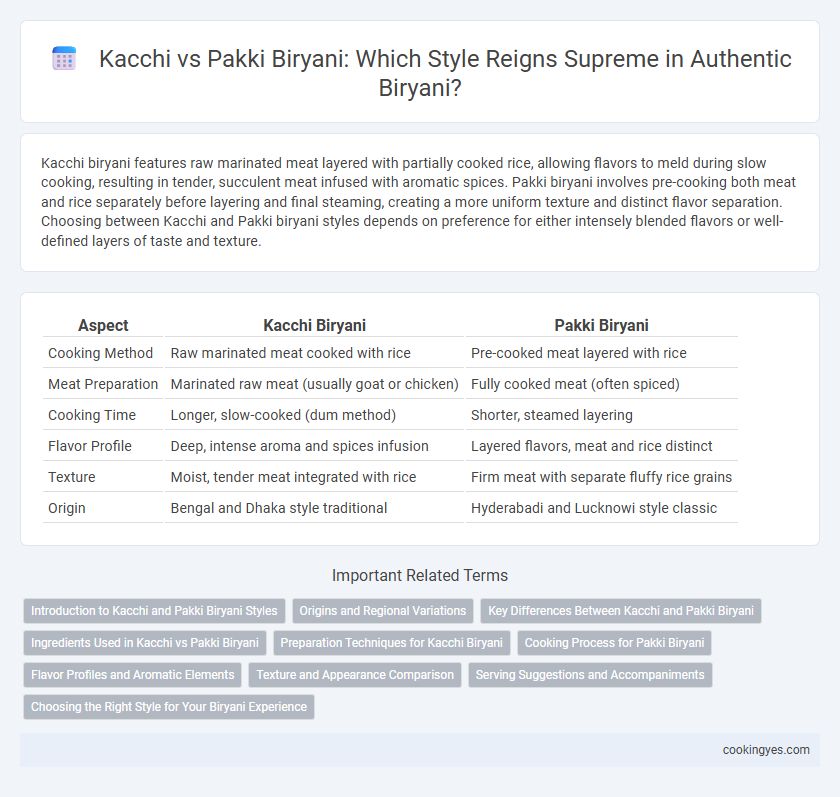Kacchi biryani features raw marinated meat layered with partially cooked rice, allowing flavors to meld during slow cooking, resulting in tender, succulent meat infused with aromatic spices. Pakki biryani involves pre-cooking both meat and rice separately before layering and final steaming, creating a more uniform texture and distinct flavor separation. Choosing between Kacchi and Pakki biryani styles depends on preference for either intensely blended flavors or well-defined layers of taste and texture.
Table of Comparison
| Aspect | Kacchi Biryani | Pakki Biryani |
|---|---|---|
| Cooking Method | Raw marinated meat cooked with rice | Pre-cooked meat layered with rice |
| Meat Preparation | Marinated raw meat (usually goat or chicken) | Fully cooked meat (often spiced) |
| Cooking Time | Longer, slow-cooked (dum method) | Shorter, steamed layering |
| Flavor Profile | Deep, intense aroma and spices infusion | Layered flavors, meat and rice distinct |
| Texture | Moist, tender meat integrated with rice | Firm meat with separate fluffy rice grains |
| Origin | Bengal and Dhaka style traditional | Hyderabadi and Lucknowi style classic |
Introduction to Kacchi and Pakki Biryani Styles
Kacchi Biryani features raw marinated meat layered with partially cooked rice, allowing flavors to infuse during slow cooking, typically sealed with dough to retain aromatic steam. Pakki Biryani involves fully cooked meat combined with cooked rice, seasoned and then layered or mixed before final cooking, offering a more uniform texture. Both styles showcase distinct regional techniques and taste profiles, highlighting diverse culinary traditions in biryani preparation.
Origins and Regional Variations
Kacchi Biryani originates from the Awadhi cuisine of Lucknow, India, featuring raw marinated meat cooked with partially cooked rice, allowing flavors to blend deeply during slow cooking. Pakki Biryani, prevalent in Hyderabad and South India, uses pre-cooked meat layered with fully cooked rice, creating distinct texture contrasts and emphasizing spices like saffron and cardamom. Regional variations highlight Kacchi Biryani's delicate balance and melding of aromas, while Pakki Biryani focuses on robust, separate flavor profiles characteristic of Deccani culinary traditions.
Key Differences Between Kacchi and Pakki Biryani
Kacchi biryani involves marinating raw meat with spices and then cooking it directly with partially cooked rice, allowing the flavors to infuse deeply during slow cooking. In contrast, Pakki biryani uses pre-cooked meat layered with fully cooked rice, resulting in a more distinct separation of flavors and textures. The key difference lies in the cooking technique, which affects texture, flavor blending, and overall aroma of each biryani style.
Ingredients Used in Kacchi vs Pakki Biryani
Kacchi biryani uses raw marinated meat, typically goat or chicken, layered with partially cooked basmati rice, infused with spices like saffron, cardamom, and cloves for slow cooking. Pakki biryani employs fully cooked meat combined with cooked rice, often incorporating fried onions, yogurt, and fresh herbs such as mint and coriander. The key ingredient difference lies in meat preparation--raw in Kacchi biryani versus cooked in Pakki--resulting in distinct textures and flavor absorption.
Preparation Techniques for Kacchi Biryani
Kacchi Biryani preparation involves marinating raw meat in yogurt and spices before layering it with partially cooked basmati rice, allowing the flavors to meld during the slow cooking process known as dum. This technique enhances the tenderness of the meat while infusing the rice with rich, aromatic flavors. Unlike Pakki Biryani, where the meat is pre-cooked, Kacchi Biryani relies on precise timing to cook both meat and rice simultaneously.
Cooking Process for Pakki Biryani
Pakki Biryani involves cooking marinated meat separately before layering it with partially cooked rice, allowing the flavors to meld during the final steaming process called "dum." The precise control of heat during this slow-cooking phase ensures tender meat and perfectly infused aromas. This method emphasizes a delicate balance of spices and moisture retention essential for the iconic texture of Pakki Biryani.
Flavor Profiles and Aromatic Elements
Kacchi Biryani features raw marinated meat cooked with rice, resulting in deeply infused spices and a tender texture, highlighted by robust flavors of saffron, cardamom, and cloves. Pakki Biryani uses cooked meat layered with partially boiled rice, emphasizing a balanced taste where fragrant herbs like mint and coriander blend seamlessly with gentle smoky notes. The aromatic elements in Kacchi Biryani are more intense and earthy, while Pakki Biryani offers a lighter, herbaceous aroma with subtle warmth from toasted spices.
Texture and Appearance Comparison
Kacchi biryani features marinated raw meat cooked with partially soaked rice, resulting in tender, succulent texture with rich, blended flavors as the spices permeate during slow cooking. Pakki biryani uses pre-cooked meat layered with fully cooked rice, offering a firmer texture with distinct separation between meat and rice grains, giving a more structured and visually defined appearance. The translucent, slightly sticky rice grains in Kacchi contrast with the fluffier, less cohesive grains of Pakki, highlighting distinct mouthfeel and presentation styles unique to each biryani method.
Serving Suggestions and Accompaniments
Kacchi Biryani is traditionally served with cooling raita made from yogurt, cucumber, and mint to balance its rich, marinated flavors, complemented by a side of salad with fresh onions and lemon wedges to enhance the tanginess. Pakki Biryani pairs exceptionally well with Mirchi ka Salan, a spicy chili curry, and a tangy tomato-based gravy called Dahi Chutney, which accentuate the fully cooked, aromatic layers of meat and rice. Both styles benefit from garnishing with fried onions, fresh coriander, and boiled eggs to add texture and visual appeal.
Choosing the Right Style for Your Biryani Experience
Kacchi biryani involves marinating raw meat that cooks with the rice, producing a delicate texture and rich aroma, ideal for those who prefer tender, flavorful bites. Pakki biryani uses pre-cooked meat layered with rice before final steaming, offering a more uniform and robust flavor, perfect for hearty meals with distinct rice and meat layers. Selecting Kacchi or Pakki depends on your preference for cooking technique, flavor intensity, and texture, enhancing your biryani experience accordingly.
Kacchi vs Pakki for Biryani style Infographic

 cookingyes.com
cookingyes.com